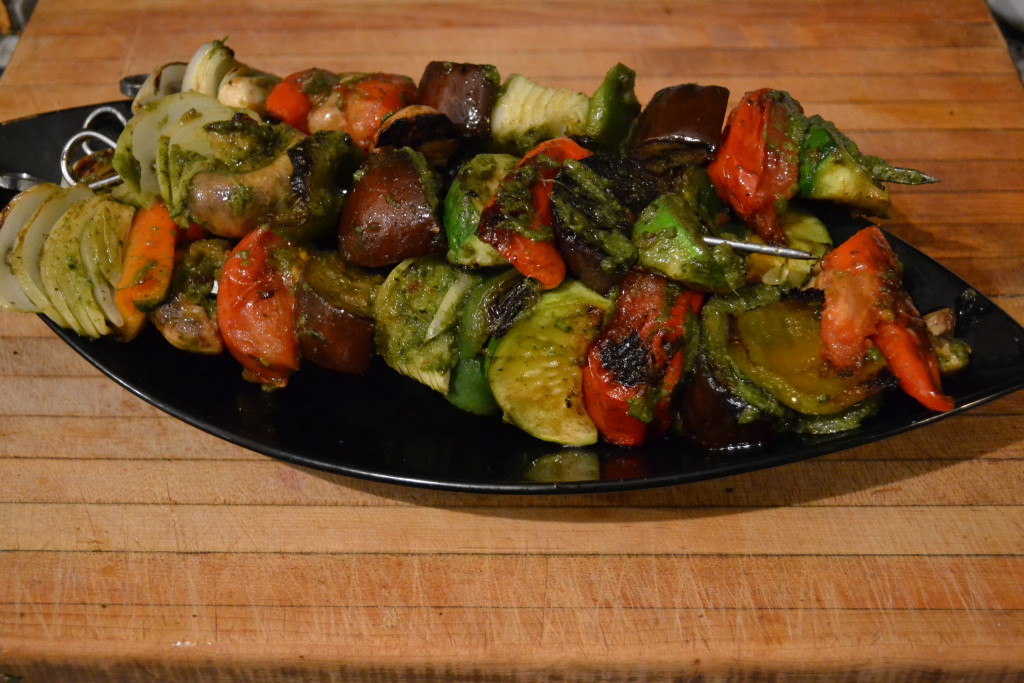On Sunday supplement
Food and Wine
With spring arriving on our doorstep the verdulerías are in bloom with a riot of color. Beautiful vegetables are piled high and calling out to be used for something, anything. And, it’s time, if you have one, to start thinking about breaking out the parrilla – scrape off all that crusty stuff left from the last barbecue – you know you said you’d get to it another day and then forgot about it. Go look, really.
Of course, not everyone has a grill at home, and for those who don’t, there’s nothing wrong with a stovetop grill, ridged or not, or even a bit hulking frying pan, preferably something heavy like cast iron. Most of the year we can’t quite get ourselves to spend the time firing up the charcoal, it’s a whole lot easier to stick the plancha on top of a couple of burners and crank the flame up underneath.
So now that we’ve got all that out of the way, some heat in the offing, and vegetables that you enjoy piled up on the counter, it’s time to get to work. We’re going to make brochettes, kebabs, skewers, spiedos, pinchos, whatever name it is you like to use. You’re going to need skewers, whether metal (much preferred for this), or wood. If you use the latter, soak them in water for an hour or two before threading the vegetables on them, it will cut down on them burning.
So here’s dinner at our house when we’re in the mood to stick a veg or two on a spike….
Vegetable Brochette
1 large onion
1 green bell pepper
2-3 red frying peppers (ají vinagres)
4-6 mushrooms
1 medium eggplant
1 medium zucchini
2 tomatoes
salt and pepper
olive oil
salsa verde
Basically, cut all the vegetables into wedges or pieces that are 2-3 cm across. Wedges are great where possible, squares, rounds, whatever works for you. And then, poke the skewers through them, mixing up the vegetables so that they look pretty. Sprinkle them with salt and freshly ground pepper, and then drizzle them lightly with olive oil on all sides.
Onto the grill with the skewers – it should be really hot to start with, we’re looking to just get a bit of a sear, or caramelization, on the surface of the vegetables. Turn them after you get a little bit of color, maybe 1-2 minutes, and just do that until all sides have a touch of browning.
At this point, turn the heat to low, or move the skewers to a low heat part of the grill. Take your salsa verde and brush the upper surface of the brochettes, and then turn that to face down. Keep doing that every couple of minutes until the vegetables are cooked through – in total, we’re looking at about 5-6 minutes for the first part of browning, and then maybe 12-15 minutes of cooking over lower heat, regularly brushing on our sauce.
When they’re cooked through and nicely browned, serve them up on a platter alongside some simple rice – whatever your preference is for type. When we can get it, we love to use wild rice or a mix of wild and white.
Salsa Verde (Green Sauce)
This is one of our staples in the kitchen, it’s incredibly simple to make, and pairs well with vegetables, meat, pasta, gnocchi – really, wherever you want an intense herb flavor. Traditionally it’s not a vegetarian sauce, but there’s an easy fix for that.
1 large bunch of mixed fresh herbs (parsley, chives, cilantro, dill – whatever you like)
1 handful of arugula leaves
3-4 anchovies (if you want to keep this vegetarian, use a tablespoonful of miso paste instead)
2 garlic cloves
1 tablespoonful of capers
6 green olives, pitted
100 ml good olive oil
salt and pepper
Put everything into a blender or food processor, set to stun, and go for it. When it’s nicely pureed (add more oil if needed to get a smooth puree), adjust the seasoning to your tastes and start using.
A series of recipes and articles that I started writing for the Buenos Aires Herald Sunday supplement, Food & Wine section, at the beginning of 2012. My original proposal to them was to take local favorite dishes and classics and lighten them up for modern day sensibilities. We’re not talking spa or diet recipes, but at the very least, making them healthier in content, particularly salt, fat and portion size. As time went by, that morphed into a recipe column that, while emphasizing food that is relatively “good for you”, wasn’t necessarily focused on local cuisine. At the beginning of 2013 I decided to stop writing for them over some administrative issues, but it was fun while it lasted.
